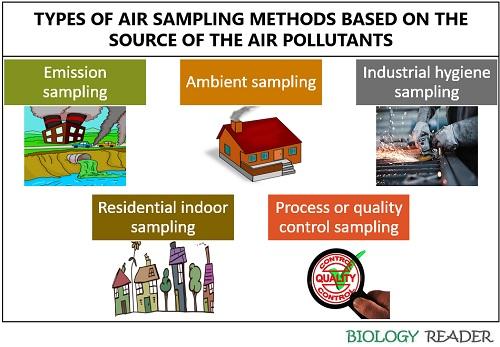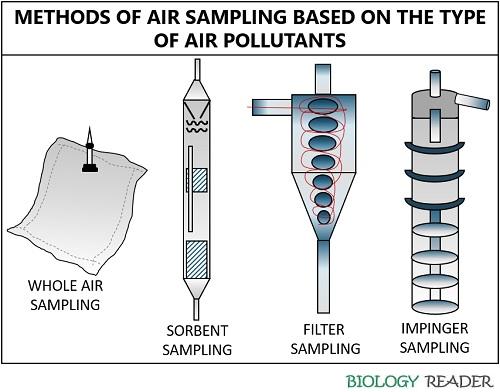Air sampling methods make the use of impaction, impingement and centrifugal collection principle to entrap the contaminants from the known volume of the air sample. The volume of collected air is first measured, and then it is expressed in the concentration against the volume of contaminated air, either in ppm (parts per million) or (mg/m3).
The volume of the air sample is calculated as a cross product of flow rate and the running time. A flow rate is the flow of air through the filter media. The air contaminants (particulate matter, aerosol etc.) are passed through the different filter media.
Air sampling mainly uses a paper filter media to collect the pollutants like (dust, fibre, aerosol, mist etc.), whereas it uses a sorbent matrix to trap the gaseous air pollutants. In this content, we will mainly focus on the definition, objectives and different types of air sampling methods.
Contents: Air Sampling Methods
Definition of Air Sampling
Air sampling acts as the pollutants monitoring tool, which detects the concentration of the particulate matter and microbial content in the atmosphere to ensure the environmental safety. Air sampling technique involves trapping of the surrounding air by using various approaches through the specialized devices or air samplers. Later, the collected air is tested for the presence of hazardous chemicals, gases, dust, fibres and microbial content in the air. It is one of the ways, by using which we can continuously monitor the level of air pollution.
Air pollutants are the potentially damaging substances like dust, fibres, harmful gases, microbes, spores etc. that can adversely affect the living system or environment. These pollutants may originate from the natural sources (forest fire, volcanic eruptions etc.) and also from the human-made or anthropogenic sources (fuel combustion, industrialization etc.). Therefore, air sampling methods introduce many possible ways to quantify the volume or concentration of the air pollutants as well as check the air quality, whether it is safe to inhale or not.
Objectives of Air Sampling Method
The air sampling methods were introduced based on the given objectives:
- To ensure atmospheric pollution saturation by employing passive and active air sampling methods.
- It also checks to what extent the air is polluted in the residential areas, workplaces, outdoors, industrial areas etc.
- To ensure the volume of particulate and microbial content in the atmosphere, so that the healthfulness and the forecast effects of a proposed new source of pollutants can be studied.
- It provides a useful tool for the evaluation of air pollution, which can continuously monitor the concentration of the air pollutants.
Types
There are five kinds of air sampling methods, depending upon the source of air pollutants.

- Emission sampling: This type of air sampling method checks the constituents, flow rate and physical properties of the exhaust gases that are released from the sources like industrial chimneys, home ventilation systems etc.
- Ambient sampling: It is the air sampling method, which evaluates the level of outdoor pollutants in many areas.
- Industrial hygiene sampling: This air sampling technique quantifies the air pollutants in the workplace to ensure employee safety.
- Residential indoor sampling: This technique evaluates the healthfulness of the indoor air.
- Process sampling: It is an air sampling technique, which monitors the presence of air pollutants during the production process of many industries.
Calculation of Contaminated Air
The concentration of the contaminated air is calculated by first measuring the volume of air sampled that is equal to the product of airflow rate and the time run. Here, the formula will be expressed as:
- The volume of air sampled = Airflow rate X Time
Then, we can get the value for the concentration of contaminated air by dividing the amount of contaminant collected to the volume of air sampled. Here, the formula will be expressed as:
- The concentration of the contaminant = Amount of contaminant collected / Volume of air sampled
The concentration of the contaminant will be expressed either in mg/m3 (for particulate matter) or in ppm (for the gaseous matter).
Methods of Air Sampling
Five techniques are commonly used to check the concentration of the atmospheric pollutants like particulates, vapour and gaseous matter. Depending upon a type of air pollutant that you want to measure, the air sampling methods are classified into the following types.

Whole air sampling: It measures the presence of volatile compounds, reduced sulphur molecules and gaseous pollutants in the atmosphere. In this type, the air is actively collected in Tedlar bags by using a pump and passively collected through a diffusion method without using a sampling pump.
Active air sampling: It quantifies the volatile and semi-volatile compounds that are present in the atmosphere. Here, the pollutants are collected inside a tube filled with solid sorbent material, and the air is trapped into the glass-tube by using a sampling pump.
Passive air sampling: It measures the atmospheric pollutants mainly microorganisms, and like active air sampling, it also makes the use of solid sorbent material to trap the contaminants. However, it does not use any sampling pump to collect the air. It depends on the principle of diffusion method.
Filter air sampling: It evaluates the concentration of the gaseous or vapour pollutants that are present in the atmosphere. This method uses filter cassettes to trap the contaminants. Then, the pollutants that are saturated over the filter cassette will chemically react with the filter media and turned into a stabilized derivative. It makes the use of different filter media.
Impinger air sampling: Here, the air is bubbled into the reactive liquid solution and allowed to react with it. Impinger air sampling method is widely used during high humidity and high temperature. It primarily evaluates the contaminants of the stationary sources and analyses the air sampled through colourimetric methods.
Conclusion
Therefore, we can conclude that there are commonly five methods of air sampling, which use different criteria to collect the air pollutants of a specific type. The pollutants in the atmosphere are categorized into the particulate, vapour and gaseous matter based on the physical properties. Thus, different types of air samplers are designed to collect the various forms of air pollutants as well as it helps us to monitor the level of air pollution in many different areas.